SLAS538B October 2007 – November 2016 TLV320AIC34
PRODUCTION DATA.
- 1 Features
- 2 Applications
- 3 Description
- 4 Revision History
- 5 Description (continued)
- 6 Device Comparison Table
- 7 Pin Configuration and Functions
- 8 Specifications
-
9 Detailed Description
- 9.1 Overview
- 9.2 Functional Block Diagram
- 9.3
Feature Description
- 9.3.1 Hardware Reset
- 9.3.2 I2C Bus Debug In A Glitched System
- 9.3.3 Digital Audio Data Serial Interface
- 9.3.4 TDM Data Transfer
- 9.3.5 Audio Data Converters
- 9.3.6 Audio Clock Generation
- 9.3.7 Stereo Audio ADC
- 9.3.8 Digital Audio Processing For Record Path
- 9.3.9 Automatic Gain Control (AGC)
- 9.3.10 Stereo Audio DAC
- 9.3.11 Digital Audio Processing For Playback
- 9.3.12 Digital Interpolation Filter
- 9.3.13 Delta-Sigma Audio DAC
- 9.3.14 Audio DAC Digital Volume Control
- 9.3.15 Increasing DAC Dynamic Range
- 9.3.16 Analog Output Common-Mode Adjustment
- 9.3.17 Audio DAC Power Control
- 9.3.18 Audio Analog Inputs
- 9.3.19 Analog Input Bypass Path Functionality
- 9.3.20 ADC PGA Signal Bypass Path Functionality
- 9.3.21 Input Impedance and VCM Control
- 9.3.22 Passive Analog Bypass During Power Down
- 9.3.23 MICBIAS_x Generation
- 9.3.24 Digital Microphone Connectivity
- 9.3.25 Analog Fully Differential Line Output Drivers
- 9.3.26 Analog High-Power Output Drivers
- 9.3.27 Short-Circuit Output Protection
- 9.3.28 Jack or Headset Detection
- 9.3.29 Output Stage Volume Controls
- 9.4 Device Functional Modes
- 9.5 Programming
- 9.6 Register Maps
- 10Application and Implementation
- 11Power Supply Recommendations
- 12Layout
- 13Device and Documentation Support
- 14Mechanical, Packaging, and Orderable Information
Package Options
Refer to the PDF data sheet for device specific package drawings
Mechanical Data (Package|Pins)
- ZAS|87
Thermal pad, mechanical data (Package|Pins)
Orderable Information
8 Specifications
8.1 Absolute Maximum Ratings
over operating free-air temperature range (unless otherwise noted)(1)| MIN | MAX | UNIT | ||
|---|---|---|---|---|
| DRVDD to AVSS_ADC, AVDD_DAC to AVSS_DAC | –0.3 | 3.9 | V | |
| DRVDD to DRVSS | –0.3 | 3.9 | V | |
| IOVDD to DVSS | –0.3 | 3.9 | V | |
| DVDD to DVSS | –0.3 | 2.5 | V | |
| AVDD_DAC to DRVDD | –0.1 | 0.1 | V | |
| Digital input voltage to DVSS | –0.3 | IOVDD + 0.3 | V | |
| Analog input voltage to AVSS_ADC, AVSS_DAC | –0.3 | AVDD_DAC + 0.3 | V | |
| Power dissipation | (TJ Max – TA) / RθJA | |||
| Junction temperature, TJ | 105 | °C | ||
| Operating temperature, TA | –40 | 85 | °C | |
| Storage temperature, Tstg | –65 | 105 | °C | |
(1) Stresses beyond those listed under Absolute Maximum Ratings may cause permanent damage to the device. These are stress ratings only, which do not imply functional operation of the device at these or any other conditions beyond those indicated under Recommended Operating Conditions. Exposure to absolute-maximum-rated conditions for extended periods may affect device reliability.
8.2 ESD Ratings
| VALUE | UNIT | |||
|---|---|---|---|---|
| V(ESD) | Electrostatic discharge | Human-body model (HBM), per ANSI/ESDA/JEDEC JS-001(1) | ±4000 | V |
| Charged-device model (CDM), per JEDEC specification JESD22-C101(2) | ±1500 | |||
(1) JEDEC document JEP155 states that 500-V HBM allows safe manufacturing with a standard ESD control process.
(2) JEDEC document JEP157 states that 250-V CDM allows safe manufacturing with a standard ESD control process.
8.3 Recommended Operating Conditions
over operating free-air temperature range (unless otherwise noted)| MIN | NOM | MAX | UNIT | ||
|---|---|---|---|---|---|
| AVDD_DAC, DRVDD(1) | Analog supply voltage | 2.7 | 3.3 | 3.6 | V |
| DVDD(1) | Digital core supply voltage | 1.65 | 1.8 | 1.95 | V |
| IOVDD(1) | Digital I/O supply voltage | 1.1 | 1.8 | 3.6 | V |
| AVDD_DAC | Analog full-scale 0-dB input voltage (DRVDD = 3.3 V) | 0.707 | VRMS | ||
| Stereo line output load resistance (codec block A and codec block B) | 10 | kΩ | |||
| Stereo headphone output load resistance (codec block A and codec block B) |
16 | Ω | |||
| Stereo speaker output load resistance (codec block A ONLY) | 8 | Ω | |||
| Digital output load capacitance | 10 | pF | |||
| TA | Operating free-air temperature | –40 | 85 | °C | |
(1) Analog voltage values are with respect to AVSS_ADC, AVSS_DAC, DRVSS; digital voltage values are with respect to DVSS.
8.4 Thermal Information
| THERMAL METRIC(1) | TLV320AIC34 | UNIT | |
|---|---|---|---|
| ZAS (NFBGA) | |||
| 87 PINS | |||
| RθJA | Junction-to-ambient thermal resistance | 53.8 | °C/W |
| RθJC(top) | Junction-to-case (top) thermal resistance | 16.3 | °C/W |
| RθJB | Junction-to-board thermal resistance | 25.3 | °C/W |
| ψJT | Junction-to-top characterization parameter | 3 | °C/W |
| ψJB | Junction-to-board characterization parameter | 26.4 | °C/W |
(1) For more information about traditional and new thermal metrics, see the Semiconductor and IC Package Thermal Metrics application report.
8.5 Electrical Characteristics
At 25°C, AVDD_DAC, DRVDD, IOVDD = 3.3 V, DVDD = 1.8 V, fS = 48-kHz, and 16-bit audio data (unless otherwise noted)| PARAMETER | TEST CONDITIONS | MIN | TYP | MAX | UNIT | ||
|---|---|---|---|---|---|---|---|
| AUDIO ADC – CODEC BLOCK A, B | |||||||
| Input signal level (0-dB) | Single-ended input | 0.707 | VRMS | ||||
| SNR | Signal-to-noise ratio(1)(2) | fS = 48 ksps, 0-dB PGA gain, LINE1LP_x and LINE1LM_x inputs ac-shorted to ground, A-weighted | 80 | 92 | dB | ||
| Dynamic range(2) | fS = 48 ksps, 0-dB PGA gain, –60-dB full-scale input signal applied at LINE1LP_x and LINE1LM_x inputs, A-weighted | 93 | dB | ||||
| THD | Total harmonic distortion | fS = 48 ksps, 0-dB PGA gain, –2-dB full-scale 1-kHz input signal applied at LINE1LP_x and LINE1LM_x inputs | –87 | –70 | dB | ||
| PSRR | Power supply rejection ratio | 217-Hz signal applied to DRVDD | 49 | dB | |||
| 1-kHz signal applied to DRVDD | 46 | ||||||
| Gain error | fS = 48 ksps, 0-dB PGA gain, –2-dB full-scale 1-kHz input signal applied on LINE1LP_x and LINE1LM_x inputs | 0.55 | dB | ||||
| Input channel separation | 1-kHz, –2-dB full-scale signal, MIC3L_x to MIC3R_x | –86 | dB | ||||
| 1-kHz, –2-dB full-scale signal, MIC2LP_x and MIC2LM_x to MIC2RP_x and MIC2RM_x | –98 | ||||||
| 1-kHz, –2-dB full-scale signal, MIC1LP_x and MIC1LM_x to MIC1RP_x and MIC1RM_x | –80 | ||||||
| ADC programmable-gain amplifier maximum gain | 1-kHz input frequency, RSOURCE < 50 Ω | 59.5 | dB | ||||
| ADC programmable-gain amplifier step size | 1-kHz input frequency, RSOURCE < 50 Ω | 0.5 | dB | ||||
| Input resistance | LINE1LP_x, LINE1LM_x, or LINE1RP_x, LINE1RM_x inputs routed to single ADC; input mix attenuation = 0 dB |
20 | kΩ | ||||
| LINE1LP_x, LINE1LM_x, or LINE1RP_x, LINE1RM_x inputs routed to single ADC; input mix attenuation = 12 dB | 80 | ||||||
| LINE2LP_x, LINE2LM_x, or LINE2RP_x, LINE2RM_x inputs routed to single ADC; input mix attenuation = 0 dB |
20 | ||||||
| LINE2LP_x, LINE2LM_x, or LINE2RP_x, LINE2RM_x inputs routed to single ADC; input mix attenuation = 12 dB | 80 | ||||||
| MIC3L_x or MIC3R_x inputs routed to single ADC, input mix attenuation = 0 dB |
20 | ||||||
| MIC3L_x or MIC3R_x inputs routed to single ADC, input mix attenuation = 12 dB | 80 | ||||||
| Input level control minimum attenuation setting | 0 | dB | |||||
| Input level control maximum attenuation setting | 12 | dB | |||||
| Input signal level | Differential input | 1.414 | VRMS | ||||
| SNR | Signal-to-noise ratio(1)(2) | fS = 48 ksps, 0-dB PGA gain, inputs ac-shorted to ground, differential mode, A-weighted | 92 | dB | |||
| THD | Total harmonic distortion | fS = 48 ksps, 0-dB PGA gain, –2-dB full-scale 1-kHz input signal, differential mode, A-weighted | –89 | dB | |||
| ANALOG PASS-THROUGH MODE – CODEC BLOCK A, B | |||||||
| rds(on) | Input-to-output switch resistance | MIC1/LINE1 to LINE_OUT | 330 | Ω | |||
| MIC2/LINE2 to LINE_OUT | 330 | ||||||
| ADC DIGITAL DECIMATION FILTER, fS = 48 kHz – CODEC BLOCK A, B | |||||||
| Filter gain from 0 to 0.39 fS | ±0.1 | dB | |||||
| Filter gain at 0.4125 fS | –0.25 | dB | |||||
| Filter gain at 0.45 fS | –3 | dB | |||||
| Filter gain at 0.5 fS | –17.5 | dB | |||||
| Filter gain from 0.55 fS to 64 fS | –75 | dB | |||||
| Filter group delay | 17/fS | s | |||||
| MICROPHONE BIAS – CODEC BLOCK A, B | |||||||
| Bias voltage | Programmable setting = 2 V, load current = 4 mA | 2 | V | ||||
| Programmable setting = 2.5 V, load current = 4 mA | 2.3 | 2.4 | 2.7 | ||||
| Programmable setting = DRVDD (3.3 V), load current = 4 mA | 3 | ||||||
| Current sourcing | Programmable setting = 2.5 V | 4 | mA | ||||
| AUDIO DAC – DIFFERENTIAL LINE OUTPUT, LOAD = 10 kΩ – CODEC BLOCK A, B | |||||||
| Full-scale output voltage | 0-dB input full-scale signal, output volume control = 0 dB, output common-mode setting = 1.35 V | 1.414 | VRMS | ||||
| SNR | Signal-to-noise ratio(3) | No input signal, output volume control = 0 dB, output common-mode setting = 1.35 V, fS = 48 kHz, A-weighted | 90 | 99 | dB | ||
| Dynamic range | –60 dB, 1-kHz input full-scale signal, output volume control = 0 dB, output common-mode setting = 1.35 V, fS = 48 kHz, A-weighted | 95 | dB | ||||
| THD | Total harmonic distortion | 0-dB, 1-kHz input full-scale signal, output volume control = 0 dB, output common-mode setting = 1.35 V, fS = 48 kHz | –88 | –75 | dB | ||
| PSRR | Power-supply rejection ratio | 217-Hz signal applied to AVDD_DAC | 77 | dB | |||
| 1-kHz signal applied to AVDD_DAC | 73 | ||||||
| DAC channel separation | 0-dB full-scale input signal between left and right lineout | 123 | dB | ||||
| DAC gain error | 0-dB, 1-kHz input full-scale signal, output volume control = 0 dB, output common-mode setting = 1.35 V, fS = 48 kHz | –0.49 | dB | ||||
| AUDIO DAC – SINGLE-ENDED LINE OUTPUT, LOAD = 10 kΩ – CODEC BLOCK A, B | |||||||
| Full-scale output voltage | 0-dB input full-scale signal, output volume control = 0 dB, output common-mode setting = 1.35 V | 0.707 | Vrms | ||||
| SNR | Signal-to-noise ratio | No input signal, output volume control = 0 dB, output common-mode setting = 1.35 V, fS = 48 kHz, A-weighted | 94 | dB | |||
| THD | Total harmonic distortion | 0-dB, 1-kHz input full-scale signal, output volume control = 0 dB, output common-mode setting = 1.35 V, fS = 48 kHz | 79 | dB | |||
| DAC gain error | 0-dB, 1-kHz input full-scale signal, output volume control = 0 dB, output common-mode setting = 1.35 V, fS = 48 kHz | –0.5 | dB | ||||
| AUDIO DAC – SINGLE-ENDED HEADPHONE OUTPUT, LOAD = 16 Ω – CODEC BLOCK A, B | |||||||
| Full-scale output voltage | 0-dB input full-scale signal, output volume control = 0 dB, output common-mode setting = 1.35 V | 0.707 | Vrms | ||||
| SNR | Signal-to-noise ratio | No input signal, output volume control = 0 dB, output common-mode setting = 1.35 V, fS = 48 kHz, A-weighted | 93 | dB | |||
| No input signal, output volume control = 0 dB, output common-mode setting = 1.35 V, fS = 48 kHz, 50% DAC current boost, A-weighted | 94 | dB | |||||
| Dynamic range | –60 dB, 1-kHz input full-scale signal, output volume control = 0 dB, output common-mode setting = 1.35 V, fS = 48 kHz, A-weighted | 89 | dB | ||||
| THD | Total harmonic distortion | 0-dB, 1-kHz input full-scale signal, output volume control = 0 dB, output common-mode setting = 1.35 V, fS = 48 kHz | –74 | –65 | dB | ||
| PSRR | Power-supply rejection ratio | 217-Hz signal applied to DRVDD, AVDD_DAC | 41 | dB | |||
| 1-kHz signal applied to DRVDD, AVDD_DAC | 44 | ||||||
| DAC channel separation | 0-dB full-scale input signal between left and right headphone out | 84 | dB | ||||
| DAC gain error | 0-dB, 1-kHz input full-scale signal, output volume control = 0 dB, output common-mode setting = 1.35 V, fS = 48 kHz | –0.8 | dB | ||||
| AUDIO DAC – LINEOUT AND HEADPHONE OUT DRIVERS – CODEC BLOCK A, B | |||||||
| Output common mode | First option | 1.35 | V | ||||
| Second option | 1.5 | ||||||
| Third option | 1.65 | ||||||
| Fourth option | 1.8 | ||||||
| Output volume-control maximum setting | 9 | dB | |||||
| Output volume-control step size | 1 | dB | |||||
| AUDIO DAC – DIFFERENTIAL SPEAKER OUTPUT, RLOAD = 8 Ω, 1 kHz INPUT SIGNAL – CODEC BLOCK A ONLY | |||||||
| Full-scale output voltage, codec block A only | 0-dB input full-scale signal, output common-mode setting = 1.35 V, output volume control = 0 dB | 1.414 | VRMS | ||||
| SNR | Signal-to-noise ratio, codec block A only | A-weighted, fS = 48 kHz, output volume control = 0 dB, no input signal, output common-mode setting = 1.35 V | 96 | dB | |||
| THD | Total harmonic distortion, codec block A only | fS = 48 kHz, 1-kHz input full-scale signal, output volume control = 0 dB, output common-mode setting = 1.35 V | –67 | dB | |||
| DAC gain error, codec block A only | fS = 48 kHz, 1-kHz input full-scale signal, output volume control = 0 dB, output common-mode setting = 1.35 V | –2 | dB | ||||
| DAC DIGITAL INTERPOLATION, FILTER fS = 48-ksps – CODEC BLOCK A, B | |||||||
| Pass band | 0 | 0.45 fS | Hz | ||||
| Pass-band ripple | ±0.06 | dB | |||||
| Transition band | 0.45 fS | 0.55 fS | Hz | ||||
| Stop band | 0.55 fS | 7.5 fS | Hz | ||||
| Stop-band attenuation | 65 | dB | |||||
| Group delay | 21 / fS | s | |||||
| DIGITAL I/O – CODEC BLOCK A, B | |||||||
| VIL | Input low level | –0.3 | 0.3 IOVDD | V | |||
| VIH | Input high level(4) | IOVDD > 1.6 V | 0.7 IOVDD | V | |||
| IOVDD < 1.6 V | 1.1 | ||||||
| VOL | Output low level | 0.1 IOVDD | V | ||||
| VOH | Output high level | 0.8 IOVDD | V | ||||
| POWER CONSUMPTION, DRVDD, AVDD_DAC = 3.3 V, DVDD = 1.8 V, IOVDD = 3.3 V – CURRENTS LISTED FOR CODEC BLOCK A OR BLOCK B | |||||||
| IIN | IDRVDD + IAVDD_DAC | RESET_x pulse applied, no external clocks | 1.19 | µA | |||
| IDVDD | RESET_x pulse applied, no external clocks | 0.75 | |||||
| IDRVDD + IAVDD_DAC | Mono ADC record, fS = 8 ksps, I2S slave, AGC off, no signal, PLL off | 2.06 | mA | ||||
| IDVDD | Mono ADC record, fS = 8 ksps, I2S slave, AGC off, no signal, PLL off | 0.55 | |||||
| IDRVDD + IAVDD_DAC | Stereo ADC record, fS = 8 ksps, I2S slave, AGC off, no signal, PLL off | 4.06 | |||||
| IDVDD | Stereo ADC record, fS = 8 ksps, I2S slave, AGC off, no signal, PLL off | 0.67 | |||||
| IDRVDD + IAVDD_DAC | Stereo ADC record, fS = 48 ksps, I2S slave, AGC off, no signal, PLL off | 4.27 | |||||
| IDVDD | Stereo ADC record, fS = 48 ksps, I2S slave, AGC off, no signal, PLL off | 2.45 | |||||
| IDRVDD + IAVDD_DAC | Stereo DAC playback to lineout, analog mixer bypassed, fS = 48 ksps, I2S slave, no signal, PLL off | 3.5 | |||||
| IDVDD | Stereo DAC playback to lineout, analog mixer bypassed, fS = 48 ksps, I2S slave, no signal, PLL off | 2.3 | |||||
| IDRVDD + IAVDD_DAC | Stereo DAC playback to Lineout, fS = 48 ksps, I2S slave, no signal, PLL off | 4.42 | |||||
| IDVDD | Stereo DAC playback to Lineout, fS = 48 ksps, I2S slave, no signal, PLL off | 2.27 | |||||
| IDRVDD + IAVDD_DAC | Stereo DAC playback to stereo single-ended headphones, fS = 48 ksps, I2S slave, no signal, PLL off | 7.78 | |||||
| IDVDD | Stereo DAC playback to stereo single-ended headphones, fS = 48 ksps, I2S slave, no signal, PLL off | 2.26 | |||||
| IDRVDD + IAVDD_DAC | Stereo linein to stereo lineout, no signal | 3.16 | |||||
| IDVDD | Stereo linein to stereo lineout, no signal | 1.79 | |||||
| IDRVDD + IAVDD_DAC | Extra power when PLL enabled | 1.2 | |||||
| IDVDD | Extra power when PLL enabled | 1 | |||||
| IDRVDD + IAVDD_DAC | All blocks powered down, headset detection enabled | 5.3 | µA | ||||
| IDVDD | All blocks powered down, headset detection enabled | 188 | |||||
(1) Ratio of output level with 1-kHz full-scale sine-wave input, to the output level with the inputs short-circuited, measured A-weighted over a 20-Hz to 20-kHz bandwidth using an audio analyzer.
(2) All performance measurements done with 20-kHz low-pass filter and, where noted, A-weighted filter. Failure to use such a filter may result in higher THD+N and lower SNR and dynamic-range readings than shown in the Electrical Characteristics. The low-pass filter removes out-of-band noise, which, although not audible, may affect dynamic specification values.
(3) Unless otherwise noted, all measurements use output common-mode voltage setting of 1.35 V, 0-dB output level control gain, 16-Ω single-ended load.
(4) When IOVDD < 1.6 V, minimum VIH is 1.1 V.
8.6 Timing Requirements
For A and B interfaces, all specifications at 25°C and DVDD = 1.8 V (unless otherwise noted)(1)| MIN | NOM | MAX | UNIT | |||
|---|---|---|---|---|---|---|
| I2S, LJF, RJF TIMING IN MASTER MODE (SEE Figure 1) | ||||||
| td(WS) | ADWS/WCLK_x delay time | IOVDD = 1.1 V | 50 | ns | ||
| IOVDD = 3.3 V | 15 | |||||
| td(DO-WS) | ADWS/WCLK_x to DOUT_x delay time | IOVDD = 1.1 V | 50 | ns | ||
| IOVDD = 3.3 V | 20 | |||||
| td(DO-BCLK) | BCLK_x to DOUT_x delay time | IOVDD = 1.1 V | 50 | ns | ||
| IOVDD = 3.3 V | 15 | |||||
| ts(DI) | DIN_x setup time | IOVDD = 1.1 V | 10 | ns | ||
| IOVDD = 3.3 V | 6 | |||||
| th(DI) | DIN_x hold time | IOVDD = 1.1 V | 10 | ns | ||
| IOVDD = 3.3 V | 6 | |||||
| tr | Rise time | IOVDD = 1.1 V | 30 | ns | ||
| IOVDD = 3.3 V | 10 | |||||
| tf | Fall time | IOVDD = 1.1 V | 30 | ns | ||
| IOVDD = 3.3 V | 10 | |||||
| DSP TIMING IN MASTER MODE (SEE Figure 2) | ||||||
| td(WS) | ADWS/WCLK_x delay time | IOVDD = 1.1 V | 50 | ns | ||
| IOVDD = 3.3 V | 15 | |||||
| td(DO-BCLK) | BCLK_x to DOUT_x delay time | IOVDD = 1.1 V | 50 | ns | ||
| IOVDD = 3.3 V | 15 | |||||
| ts(DI) | DIN_x setup time | IOVDD = 1.1 V | 10 | ns | ||
| IOVDD = 3.3 V | 6 | |||||
| th(DI) | DIN_x hold time | IOVDD = 1.1 V | 10 | ns | ||
| IOVDD = 3.3 V | 6 | |||||
| tr | Rise time | IOVDD = 1.1 V | 30 | ns | ||
| IOVDD = 3.3 V | 10 | |||||
| tf | Fall time | IOVDD = 1.1 V | 30 | ns | ||
| IOVDD = 3.3 V | 10 | |||||
| I2S, LJF, RJF TIMING IN SLAVE MODE (SEE Figure 3) | ||||||
| tH(BCLK) | BCLK_x high period | IOVDD = 1.1 V | 70 | ns | ||
| IOVDD = 3.3 V | 35 | |||||
| tL(BCLK) | BCLK_x low period | IOVDD = 1.1 V | 70 | ns | ||
| IOVDD = 3.3 V | 35 | |||||
| ts(WS) | ADWS/WCLK_x setup time | IOVDD = 1.1 V | 10 | ns | ||
| IOVDD = 3.3 V | 6 | |||||
| th(WS) | ADWS/WCLK_x hold time | IOVDD = 1.1 V | 10 | ns | ||
| IOVDD = 3.3 V | 6 | |||||
| td(DO-WS) | ADWS/WCLK_x to DOUT_x delay time (for LJF mode only) |
IOVDD = 1.1 V | 50 | ns | ||
| IOVDD = 3.3 V | 20 | |||||
| td(DO-BCLK) | BCLK_x to DOUT_x delay time | IOVDD = 1.1 V | 50 | ns | ||
| IOVDD = 3.3 V | 20 | |||||
| ts(DI) | DIN_x setup time | IOVDD = 1.1 V | 10 | ns | ||
| IOVDD = 3.3 V | 6 | |||||
| th(DI) | DIN_x hold time | IOVDD = 1.1 V | 10 | ns | ||
| IOVDD = 3.3 V | 6 | |||||
| tr | Rise time | IOVDD = 1.1 V | 8 | ns | ||
| IOVDD = 3.3 V | 4 | |||||
| tf | Fall time | IOVDD = 1.1 V | 8 | ns | ||
| IOVDD = 3.3 V | 4 | |||||
| DSP TIMING IN SLAVE MODE (SEE Figure 4) | ||||||
| tH(BCLK) | BCLK_x high period | IOVDD = 1.1 V | 70 | ns | ||
| IOVDD = 3.3 V | 35 | |||||
| tL(BCLK) | BCLK_x low period | IOVDD = 1.1 V | 70 | ns | ||
| IOVDD = 3.3 V | 35 | |||||
| ts(WS) | ADWS/WCLK_x setup time | IOVDD = 1.1 V | 10 | ns | ||
| IOVDD = 3.3 V | 6 | |||||
| th(WS) | ADWS/WCLK_x hold time | IOVDD = 1.1 V | 10 | ns | ||
| IOVDD = 3.3 V | 6 | |||||
| td(DO-BCLK) | BCLK_x to DOUT_x delay time | IOVDD = 1.1 V | 50 | ns | ||
| IOVDD = 3.3 V | 20 | |||||
| ts(DI) | DIN_x setup time | IOVDD = 1.1 V | 10 | ns | ||
| IOVDD = 3.3 V | 6 | |||||
| th(DI) | DIN_x hold time | IOVDD = 1.1 V | 10 | ns | ||
| IOVDD = 3.3 V | 6 | |||||
| tr | Rise time | IOVDD = 1.1 V | 6 | ns | ||
| IOVDD = 3.3 V | 4 | |||||
| tf | Fall time | IOVDD = 1.1 V | 6 | ns | ||
| IOVDD = 3.3 V | 4 | |||||
(1) All timing specifications are measured at characterization but not tested at final test.
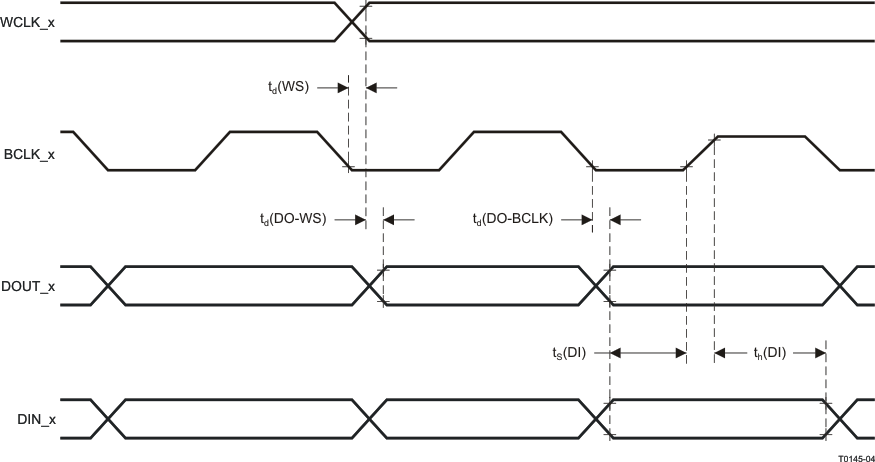 Figure 1. I2S, LJF, RJF Timing in Master Mode
Figure 1. I2S, LJF, RJF Timing in Master Mode
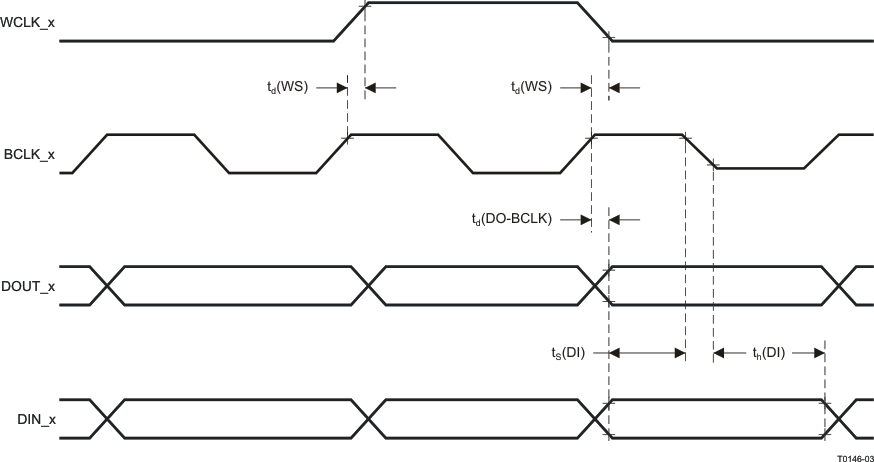 Figure 2. DSP Timing in Master Mode
Figure 2. DSP Timing in Master Mode
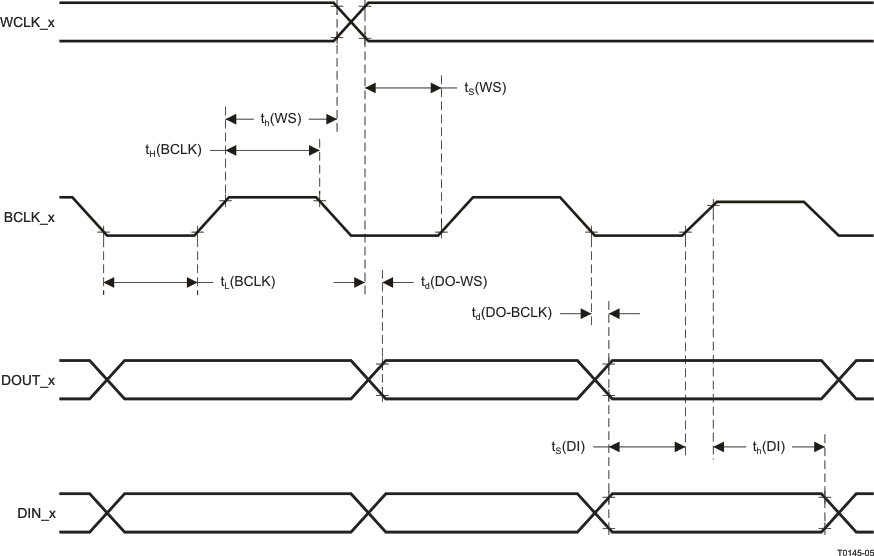 Figure 3. I2S, LJF, RJF Timing in Slave Mode
Figure 3. I2S, LJF, RJF Timing in Slave Mode
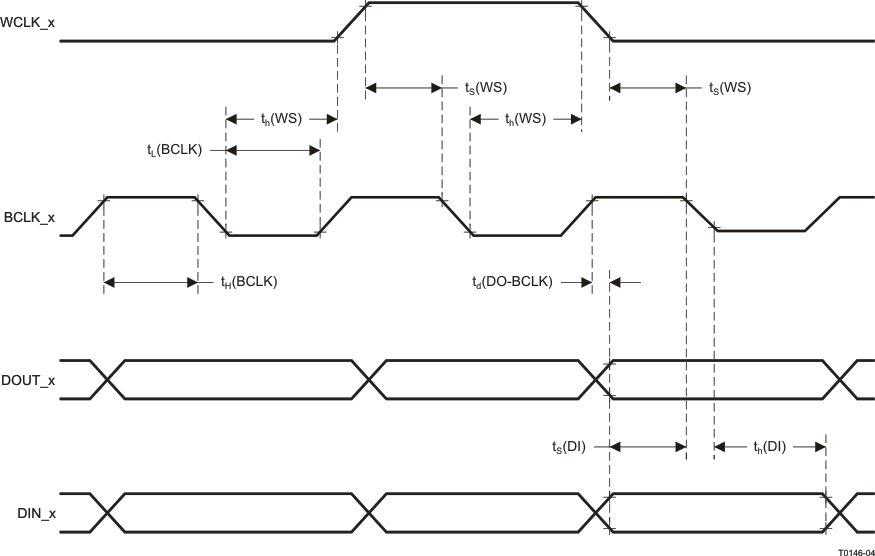 Figure 4. DSP Timing in Slave Mode
Figure 4. DSP Timing in Slave Mode
8.7 Typical Characteristics
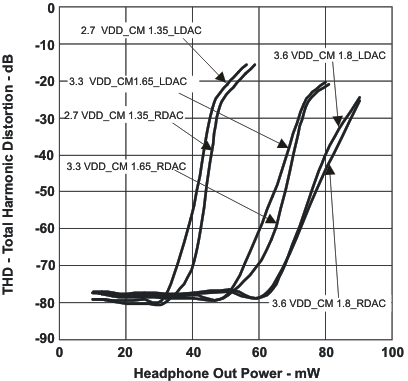 Figure 5. Total Harmonic Distortion
Figure 5. Total Harmonic Distortionvs Headphone Out Power
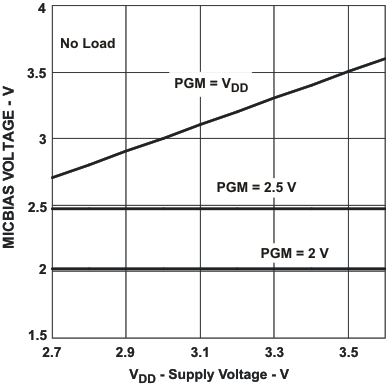 Figure 7. MICBIAS_x Voltage vs Supply Voltage
Figure 7. MICBIAS_x Voltage vs Supply Voltage
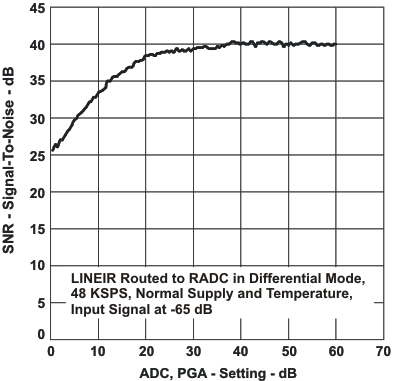 Figure 6. Signal-to-Noise Ratio
Figure 6. Signal-to-Noise Ratiovs ADC PGA Setting
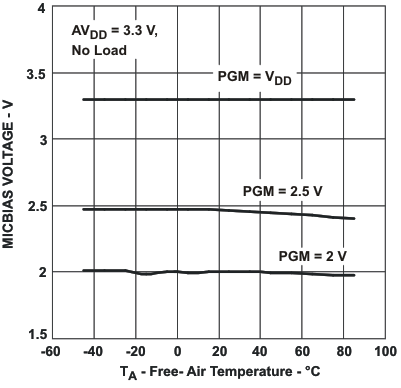 Figure 8. MICBIAS_x Voltage
Figure 8. MICBIAS_x Voltagevs Free-Air Temperature
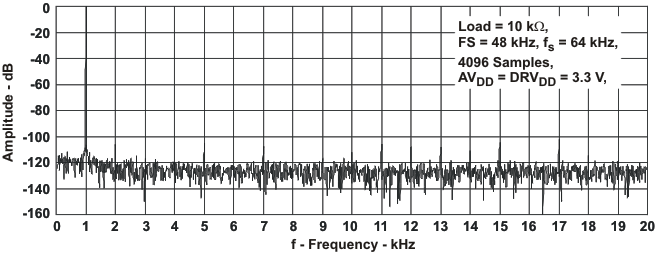 Figure 9. Left-DAC FFT
Figure 9. Left-DAC FFT
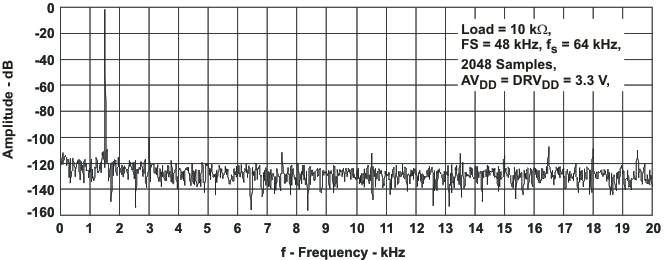 Figure 11. Left-ADC FFT
Figure 11. Left-ADC FFT
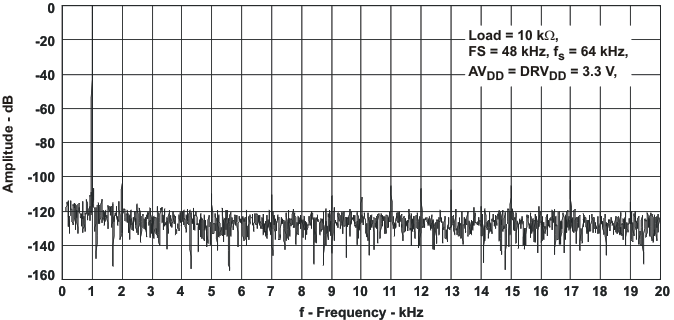 Figure 10. Right-DAC FFT
Figure 10. Right-DAC FFT
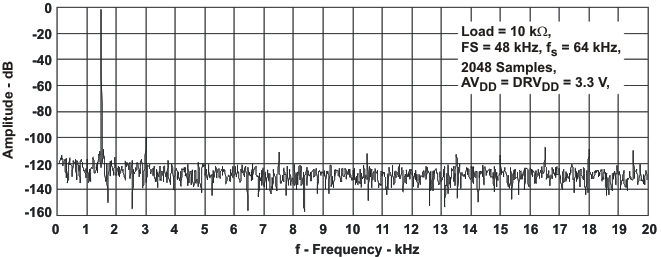 Figure 12. Right-ADC FFT
Figure 12. Right-ADC FFT